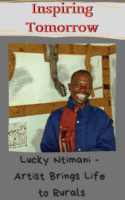The multi-talented artist Lucky Ntimani continues to produce more amazing work and transferring his artistic skills to the youths in the rural areas, and thus keeping the youths out of the harsh streets through keeping their focus on art.
He is a singer, versatile music instrumentalist, illustrator, and sculptor. Lucky quit a permanent job at a fruit and vegetable market in Gauteng and returned to Mbhokota village, outside Elim in Limpopo, to pursue his artistic route.
“In Gauteng, a man saw me turning Masonite boards into designs which included framed messages and other stuff, and advised me to follow my talent.”
This artist’s art was strengthened when the local internationally acclaimed sculptor, Thomas Kubayi, recommended him for a craftsmanship course, which was conducted in the mountain. With the help from the hub of art in Limpopo known as Madi a Thavha, Lucky managed to master sculpture-making, and his art has become financially viable in the market.
“Art is my life – I live on art since it has become my only means of earning bread. But my clients are mostly people from far away in the cities and overseas. Our communities seem to be losing touch with art, forgetting that art forms part of our heritage as Africans.”
He is one artist who possesses the ability to hew any given piece of wood into any article resembling reality or what he has seen in his dreams. Apart from possessing the ability to play with ease any musical instruments familiar in southern Africa, he also creates musical instruments of his own using a small table, steel plate and a piece of wire.
“This is one music instrument which I invented – and my regular guests from Germany, London, Australia, Netherlands, and France love it. When I play it, they get intrigued. It fills them with wonder and awe to see that one can use a discarded material to produce an amazing musical instrument.”
Lucky has also started facilitating art workshops and skills-transfer programmes for the local youths who all flood his yard after school. For that purpose, he had built an all-side open shelter which he uses for a classroom.
“My children are quite amazing; they grasp the basics so fast and place a challenge among themselves to produce the best of sounds or sculptures. We also have a big marimba troupe. I made the marimba instruments myself and gave them a unique tuning.”
The now internationally-recognized sculptor and indigenous musician, Lucky is hailed as one of the finest sculptors to ever come out of the village, which is known for several internationally-acclaimed sculptors. He maintains that he was born an artist.
“I started noticing that I was an artist at the age of 14 when I told cultural stories to my peers and also composed songs of my own. I breathe life into my art.”
His yard is decorated with statuettes, figurines and other creations of different sizes and shapes which all tell an artistic story of their own.
Kubayi had to say this about Lucky: “He is a disciplined sculptor, who spends most of his time working on his art. He doesn’t copy his teachers or mentors. He has developed a style of his own. I also like the fact that he is grooming new talent within his community.”
***
Tell us: What did you learn from Lucky’s story?







